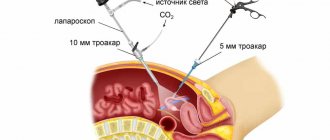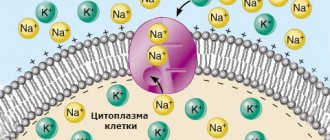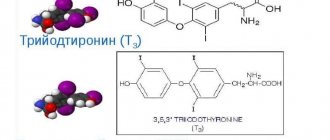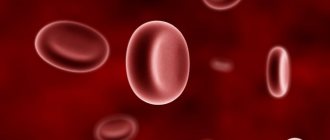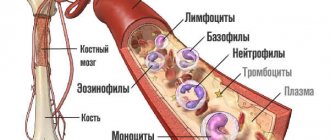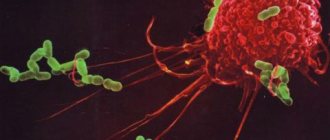In the case when a pediatrician draws attention to an incomprehensible decrease in leukocytes and neutrophils in a child’s blood, he most often sends him for a consultation with a pediatric hematologist. And for this specialist, neutropenia occurring in children is a common occurrence in everyday practice. Most often, a pediatric hematologist deals with acquired forms of this condition, which most often proceed well and end with normalization of the number of this type of leukocyte. Among them is the so-called benign neutropenia of childhood.
Congenital neutropenias are much less common, and if they are not treated correctly and for a long time, they can cause serious complications, even death. What is benign neutropenia? When does it occur, why, and what are the features of its course? First of all, you need to determine the quantitative indicators of neutrophils.
Neutrophil levels in children and some reasons for their decline
In pediatric practice, it is believed that if the number of neutrophils in the peripheral blood of a child is less than 1 million, or 1 * 109 / l under the age of one year, then this is neutropenia.
And at the age of over a year, the diagnosis can be made if their number is less than 1.5 * 109/l.
Of course, acquired such conditions are much more common than congenital ones. Oncohematologists know that a severe variant may be induced or secondary aplasia of hematopoiesis, including the leukocyte lineage. The cause may be cancer treatment. But here we are not talking about malignant neoplasms, and not about chemotherapy or stem cell transplantation.
You will also find our other article useful - Low neutrophils in children.
Banal infections
Much more often in children, neutropenia occurs due to acute infections. Few people know, but any viral infection, as well as many bacterial diseases, are often accompanied by a temporary or transistor drop in the concentration of neutrophils in the child’s blood. The neutrophil count returns to normal as health improves. Such neutropenia is never accompanied by complications.
Medicinal causes
Neutropenia caused by drugs is somewhat less common, and parents should definitely be aware of this. Some medications can destroy blood cells because they interfere with immune reactions. Thus, drugs can be called partial antigens, which are called haptens. Doctors have noticed that if the number of neutrophils in a child’s blood drops 2 weeks after starting to take any medicine, then this medicine may be the cause of such iatrogenic neutropenia. What medications can affect the composition of a baby's white blood? We need to list them:
- A significant group of antibiotics. These are cephalosporins, gentamicin, lincomycin, streptomycin, anti-tuberculosis antibiotics (rifampicin, isoniazid), Biseptol or trimethoprim;
- Acyclovir;
- Acetylsalicylic acid (which is strictly forbidden to be given to children under 14 years of age), Ibuprofen, indomethacin;
- Carbamazepine, diazepam, sodium valproate. These drugs are used for convulsive conditions in children.
- Beta-blockers, nifedipine, and 1st generation antihistamines—Pipolfen or Diprazine—can also cause neutropenia.
Some other drugs: spironolactone, penicillamine, famotidine, colchicine and so on.
Complications and consequences
Neutropenia is most dangerous because of the complications that arise from the disease. There is a high risk of infection when coming into contact with infected patients or open wounds. Therefore, children with neutropenia should follow a number of recommendations.
- Pay close attention to your personal hygiene.
- If abrasions, wounds or cuts appear, be sure to treat the damaged areas with an antiseptic.
- Don't forget about oral care and visit your dentist regularly.
- Try to avoid crowded places where you can become infected.
- Do not neglect routine and preventive vaccinations (except in cases of immunodeficiency syndrome).
- If any symptoms or complications occur, contact your healthcare provider immediately.
Neutropenia is a diagnosis that requires competent treatment and constant monitoring. However, in practice, most often there are mild forms of the disease, which go away on their own after some time. In severe forms, neutropenia can also be treated. The main thing is to notice the symptoms in time and adhere to the prescribed treatment regimen.
Transient allogeneic and autoimmune form
In addition to the drug cause, the child may experience neutropenia of immune origin when its own neutrophils are destroyed by autoantibodies (either its own or maternal). In this case, the diagnosis is made when antibodies are detected. A characteristic representative of such a disease can be considered the so-called neonatal alloimmune neutropenia, which develops according to a mechanism similar to Rh conflict. This name can be translated as “a decrease in neutrophils that occurs soon after birth due to foreign antibodies.” How to understand this? The mother's body produces antibodies against the antigens of the unborn child, which are located on neutrophils. This type of neutropenia usually does not need to be treated, and it goes away on its own when the maternal antibodies in the blood of the newborn baby, which entered the bloodstream before birth, gradually disappear.
Sometimes autoimmune neutropenia occurs in babies when autoantibodies are produced to neutrophil structures, which are considered surface antigens for antibodies. This condition can develop due to any disease, such as systemic lupus erythematosus, rheumatoid arthritis (juvenile form), and the treatment of this neutropenia is the treatment of the underlying disease.
Primary immune neutropenia, which is not associated with systemic disease, occasionally occurs. It appears in the first three years of a baby’s life, is benign in nature (but this is not the benign neutropenia in children discussed in the title), and after a few years it goes away on its own, in 90% of cases.
In order to confirm the autoimmune origin of neutropenia, both primary and secondary, antibodies to neutrophils should be determined in a laboratory manner. This is the so-called anti-granulocyte antibody test. If anti-granulocyte antibodies are not found, then autoimmune neutropenia becomes idiopathic, which means “arising for unknown reasons.”
Usually these babies have normal red bone marrow. Granulocytes grow well in it, and such idiopathic neutropenia occurs practically without complications, and such a diagnosis is established only after excluding all other possible causes of neutropenia: autoimmune, secondary, and so on.
Symptoms
If there are any signs of illness, do not risk your child’s health - consult a doctor! Choose a specialist yourself or contact our help desk. The best doctors in Moscow are ready to see you:
298 pediatricians, 4 hematologists, 1 of them takes house calls.
In the vast majority of cases, the condition is asymptomatic and is detected accidentally, as part of a routine examination, when it is impossible to accurately determine either the onset of its development or the causes.
Congenital pathologies make themselves felt already in the neonatal period. An infant may have breathing problems, pulmonary edema, and inflammatory diseases of the oral cavity (stomatitis, gingivitis). Long-term healing of wounds is noted, primarily the umbilical one. These are nonspecific symptoms that may indicate a variety of diseases and pathologies, so you should consult your doctor.
Benign neutropenia – what is it?
There is another option, the “most” classic one. This is what is called benign neutropenia of childhood. Many hematologists and pediatricians distinguish it as a separate species, into a separate nosological category, and some do not consider this condition a disease at all. And, most likely, they are right.
Most often, this neutropenia is detected either in the first or second year of life, and quite by accident, when a blood test is routine. The child is feeling well. Even if the number of neutrophils in a baby is half the norm, that is, 0.5 * 109 / l, infectious diseases are almost never observed. And if the baby does get sick, neutrophils quickly appear in the blood and reach normal values. How to explain this strange situation? Explanation: Margination
Diagnosis of the disease
Neutropenia can be diagnosed based on the results of a complete blood count. Most often, the disease is detected by chance when the child undergoes a routine examination.
When interpreting a blood test, it is important to take into account the absolute value of neutrophils (in conventional units of “cells per microliter of blood”), and not the relative value (as a percentage). Many clinics use test forms in which neutrophils are expressed as a percentage. In this case, absolute values are calculated manually.
Based on the severity of the disease, neutropenia is divided into three degrees:
- Light – from 1000 to 1500 cells/µl.
- Average – from 500 to 1000 cells/µl.
- Severe – from 100 to 500 cells/µl.
To identify a complete picture, the doctor usually prescribes periodic general blood tests. Over the course of 1-2 months, tests are carried out on average 3 times a week in order to confirm or exclude cyclic neutropenia.
Margination
Why does this benign neutropenia occur in children under one year of age? One of the most reasonable explanations is the so-called margination - the marginal standing of leukocytes. What does this mean? The answer is very simple: this is a hemodynamic phenomenon, the relationship between the position of blood cells in a vessel in relation to the central zone of blood flow.
In general, the number of neutrophils in the blood is normal, everything is fine. When taking blood from a finger prick, the number of neutrophils is also normal. But when you try to take blood from a vein, neutrophils do not get into the needle. The thing is that blood cells, neutrophils, do not move in the center of the venous vessel, where the flow is strongest. They are evicted from the central bloodstream to the periphery. They make their way along the vascular wall, along the endothelium. This is margination, or marginal standing of neutrophils.
Thus, the phenomenon of benign neutropenia may be erroneous and represent a so-called artifact detected during blood sampling. Therefore, no additional diagnostic measures, much less therapeutic ones, are required, but you just need to take blood from a finger, or capillary blood.
When is treatment needed?
And when is serious diagnosis and treatment required? In the event that the baby is diagnosed with congenital neutropenia. There are several such conditions, but all are severe genetic disorders that may be dominant, recessive, or sex-linked, and the incidence of severe congenital neutropenia in children is currently one case per 200,000 or 300,000 population.
After diagnosis, all such babies are given pathogenetic continuous therapy with a colony-stimulating factor, for example, Leucostim or Neupogen. In the event of a severe infectious disease, such children are transfused with donor leukocyte plasma. If there is no effect from the administration of colony-stimulating factors, then the only treatment option is bone marrow transplantation.
Treatment methods and drugs
Most often, mild forms of neutropenia occur in children, which do not require constant intervention. It is recommended to take medications that support the immune system, and special attention to the child’s personal hygiene, especially the oral cavity.
In more serious cases, treatment is selected depending on the nature of the disease and the reasons that caused the syndrome. If neutropenia occurs as a result of taking medications or against the background of another disease, then first of all the already prescribed treatment is adjusted.
The complex of further actions combines the use of antibiotics, vitamins, excipients for the gastrointestinal tract and immunostimulants. In case of chronic syndrome, a strategy of continuous maintenance therapy is usually chosen. With this type of treatment, drugs are administered periodically, preventing the acute stage.
In the most severe forms, surgery (removal of the affected organs) or a bone marrow transplant may be required. The latter procedure can only be performed on children over 12 years of age.
